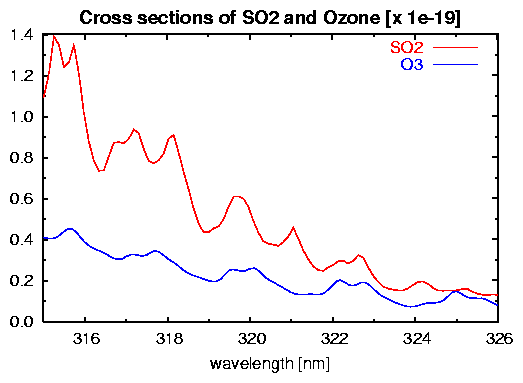| |
SO2 slant column retrieval
The SO2 slant column density, usually given in
Dobson Units (DU),
are retrieved from UV measurements made by satellite based instruments,
such as SCIAMACHY (in the nadir-viewing mode) and GOME-2.
The retrieval method applied to the measurements of these instruments
is the Differential Optical Absorption Spectroscopy (DOAS) technique.
SO2 data based on OMI is derived in a somewhat different way: with a "band
residual method" using the residuals of the DOAS-based ozone retrieval.
More info and links can be found in the section on the
SO2 column from OMI.
The retrieval of the SO2 slant column is done from the spectrum in the
wavelength range 315-326 nm, where SO2 shows clear absorption
features. In the same wavelength range, however, there is also absorption by
ozone (O3). The retrieval must therefore take both SO2 and O3 into account.
There is, so to say, an "interference" of the two absorption signals when
matching the measured spectrum with the absorption cross sections of SO2 and
ozone.

|
|
Cross sections of SO2 (red) and ozone (blue) in the wavelength range
used for the SO2 slant column retrieval.
|
The result of this "interference" is that when concentrations of SO2 are
low, the retrieval may give negative SO2 slant column values, with an error
of the same magnitude. This then represents the SO2 background level,
i.e. the apparent SO2 absorption in the absence of emissions of SO2.
The negative values are, of course, not physical, but due to the fact that
it is not possible to retrieve SO2 independently from ozone.
For low Solar Zenith Angles (SZAs), i.e. at low and mid latitudes,
the SO2 background level is of the order of 1 Dobson Unit (DU) and emissions
of SO2 (by pollution or volcano eruptions) will be visible against this
background.
For higher SZAs, however, there is a problem. The higher the SZA, the longer
the slant path is along which the retrieval takes place. Because of the
vertical and horizontal distribution of ozone in the atmosphere (with a
strong concentration in the lower stratosphere, the "ozone layer") a longer
slant path means a larger relative absorption by ozone. For SO2 this is much
less the case, as SO2 emissions generally show a rather limited distribution
horizontally and vertically.
Effectively this means that at higher SZAs the "interference" between the
SO2 and O3 absorption results in more negative SO2 slant column values, with
large errors. This effect is corrected for by the
background correction which is applied
to the slant column data.
Slant column error
The data files delivered via the website contain the value of the slant
column density (SCD) in Dobson Units and an estimate for the retrieval
error on the SCD, also in Dobson Units. This error does not take into
account any errors in the background correction, the air-mass factor, or
other steps in the process: the error just reflects the error due to the
DOAS retrieval of the slant column.
Slant column retrieval details
In the DOAS retrieval the following trace gases are fitted in the wavelength
range 315-326 nm: SO2 and ozone at two temperatures (223 and
243 K). Furthermore two Ring spectra are fitted to correct for the
Raman scattering, one to account for the general Ring effect of the
Fraunhofer, one for the contribution of ozone (which in fact depends on the
solar zenith angle).
In addition a correction for polarisation effects
and a wavelength calibration using a high-resolution solar spectrum are
performed.
|
|